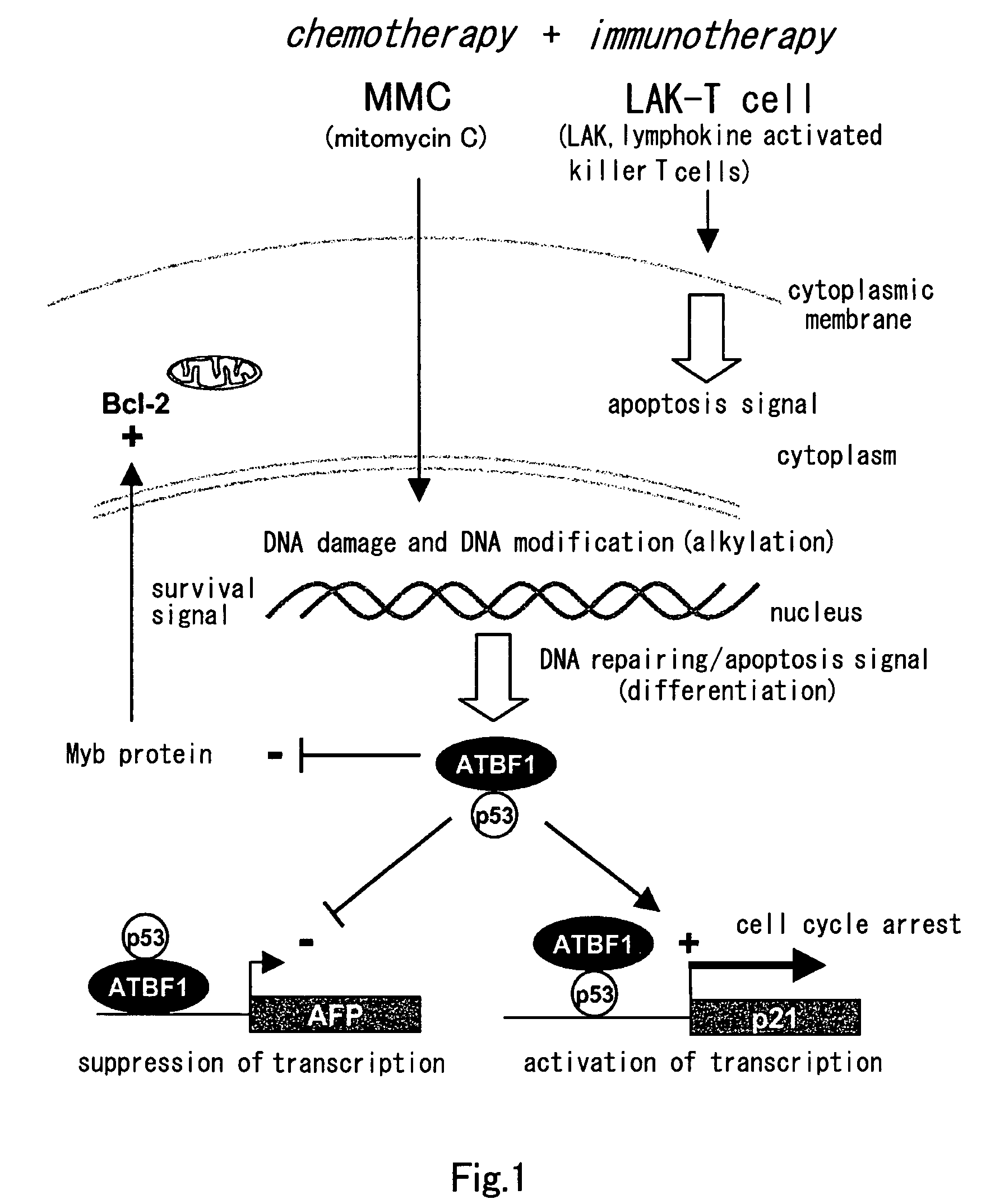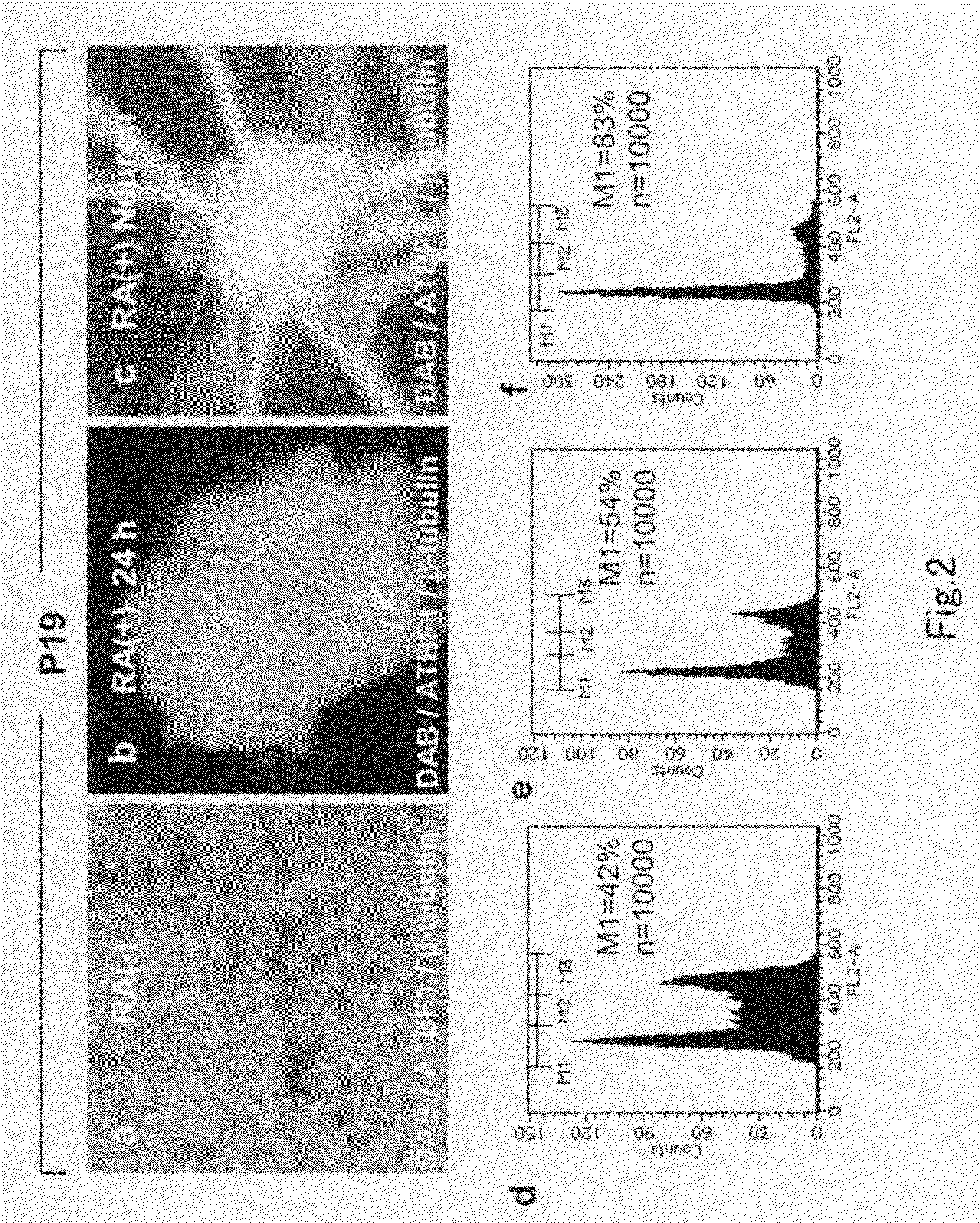Method of judging grade of malignancy of carcinoma cell using ATBF-1
a cancer cell and grade technology, applied in the field of determining can solve the problems of recurrence, poor prognosis, progression of pathologic conditions, etc., and achieve the effect of easy metastatic property and determination of the grade of cancer cell malignancy
- Summary
- Abstract
- Description
- Claims
- Application Information
AI Technical Summary
Benefits of technology
Problems solved by technology
Method used
Image
Examples
example 1
[0199]The present inventors discovered a new fact, as a result of study of molecular interaction by a yeast two-hybrid method that is a molecular-biological technique, ATBF1 that is a DNA binding transcription regulation factor is bonded not only to DNA but also to cytoskeleton protein GFAP (glial fibrillary acidic protein) that is present in the cytoplasm. Conventionally, it has been naturally expected and observed that a DNA binding protein is present in the nucleus in a physiological state. However, ATBF1 is also expected to be nucleoprotein but probability has been shown that ATBF1 not only functions in the nucleus but also exists in the cytoplasm in a state in which it is bonded to a cytoskeleton protein. This is a starting point from which the present inventors found the movement between the nucleus and cytoplasm in the present time. Moreover, as shown in the previous publication (non-patent document 6), in the other experiment system using a cultured gastric cancer cell, the ...
example 2
2-1. Preparation of Antigen
[0200]A recombination peptide obtained by fusing mouse 41 amino acid residues (2114˜2154: LQTLPAQLPPQLGPVEPLPADLAQLYQHQLNPTLLQQQNKR: SEQ ID NO: 1) of ATBF1 (Ido et al., (1996). Gene, 168, 227-231) into glutathione S transferase (GST) was used as an antigen. Note here that the above-mentioned 41 amino acid residues completely agree with amino acid residues (2170 to 2147) of human ATBF1.
[0201]Specifically, the antigen was prepared by the below-mentioned (1) and (2). Details of preparation of antigen and production of antibody are descried in the previous document (J. Comparative Neurology (2003) 465: 57-71: non-patent document 3).
[0202](1) As mentioned above, a part of the target amino acid was cut out from mouse cDNA and recombined (subcloned) into a vector, pGEX-KT, for producing GST fusion protein was carried out. (2) A gene was introduced into Escherichia coli AD202 and a protein expressed by AD202 was purified by a usual method by using Sepharose-glutat...
example 3
[0205]The present inventors carried out an experiment for differentiating undifferentiated cultured cancer cell to a nerve cell by using a P19 mouse embryonal carcinoma cultured cell and investigated the relationship between the ATBF1 expression and the cell cycle in the process.
3-1. ATBF1 Expression at Starting Time of Culturing P19 and Cell Cycle
[0206]The present inventors harvested cells in an undifferentiated proliferation state, to which stimulation had not been particularly applied, when at the starting time of culturing P19 carcinoma cells, and carried out an immunohistochemical staining method (ATBF1 staining using D1-120) by the following procedures. The cells were cultured in a chamber slide and fixed in 4% paraformaldehyde that had been adjusted with PBS, followed by washing. A primary antibody solution obtained by dissolving an anti-ATBF1 antibody in 0.05M Tris buffer solution (pH 7.6, containing 1% solution of bovine serum albumin and sodium azide) so that the concentra...
PUM
| Property | Measurement | Unit |
|---|---|---|
| pH | aaaaa | aaaaa |
| pH | aaaaa | aaaaa |
| diameter | aaaaa | aaaaa |
Abstract
Description
Claims
Application Information
 Login to View More
Login to View More - R&D
- Intellectual Property
- Life Sciences
- Materials
- Tech Scout
- Unparalleled Data Quality
- Higher Quality Content
- 60% Fewer Hallucinations
Browse by: Latest US Patents, China's latest patents, Technical Efficacy Thesaurus, Application Domain, Technology Topic, Popular Technical Reports.
© 2025 PatSnap. All rights reserved.Legal|Privacy policy|Modern Slavery Act Transparency Statement|Sitemap|About US| Contact US: help@patsnap.com



